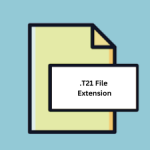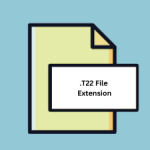.ENQ File Extension

EndNote Search Options File
| Developer | Clarivate |
| Popularity | |
| Category | Data Files |
| Format | .ENQ |
| Cross Platform | Update Soon |
What is an ENQ file?
.ENQ files are associated with EndNote, a reference management software used by researchers, academics, and professionals to manage bibliographies and references when writing research papers, theses, and dissertations.
These files are specifically known as EndNote Search Options Files, which contain settings related to search queries and preferences within the EndNote software.
More Information.
The .ENQ file format was introduced as a means to store search options within EndNote. These options include various parameters such as search fields, sorting preferences, and display settings used within the software’s search function.
This feature allows users to customize their search experience and tailor it to their specific needs and research workflows.
Origin Of This File.
The .ENQ file extension is unique to EndNote and is primarily used within the ecosystem of this software. EndNote, developed by Clarivate Analytics, has been a staple tool for researchers since its inception.
It offers features to organize references, create bibliographies, and streamline the process of citing sources in academic writing.
File Structure Technical Specification.
.ENQ files are typically binary files, meaning they contain data in a format that is not easily human-readable.
The structure of these files is specific to the EndNote software and is designed to store information related to search settings efficiently.
While the exact technical specifications of the .ENQ file formats are proprietary and not publicly disclosed by Clarivate Analytics, they are optimized to store and retrieve search options effectively within the EndNote environment.
How to Convert the File?
.ENQ files are proprietary to EndNote, conversion to other formats may not be straightforward. However, users can export their search options from EndNote in alternative formats such as XML or plain text, depending on their needs. To do this:
- Open EndNote and navigate to the search options menu.
- Select the option to export search settings.
- Choose the desired export format, such as XML or plain text.
- Save the exported file to the desired location on your computer.
Converting .ENQ files to other formats may involve manual reconfiguration of search options in the target software, as direct conversion tools may not be readily available.
Advantages And Disadvantages.
Advantages:
- Customization: Users can tailor their search options to suit their research requirements, enhancing efficiency and productivity.
- Consistency: Saved search options ensure consistency in search criteria across different sessions and projects.
- Time-saving: By saving preferred search settings, users can quickly access them without the need to redefine parameters for each search query.
Disadvantages:
- Limited interoperability: .ENQ files are specific to EndNote and may not be compatible with other reference management software.
- Dependency: Users relying heavily on customized search options may face difficulties if they need to switch to a different reference management tool.
- Complexity: Understanding and managing .ENQ files may require familiarity with EndNote’s interface and functionality, which could pose a learning curve for new users.
How to Open ENQ?
Open In Windows
- Ensure that you have EndNote installed on your Windows computer.
- Double-click the .ENQ file, and it should automatically open in EndNote, displaying the saved search options.
Open In Linux
Open In MAC
- Make sure you have EndNote installed on your Mac.
- Double-click the .ENQ file, and it should open in EndNote, showing the configured search settings.
Open In Android
- Install the EndNote app from the App Store on your iOS device.
- Transfer the .ENQ file to your iOS device using cloud storage or email.
- Open the EndNote app, navigate to the location where the .ENQ file is saved, and tap on it to open and view the search options.













